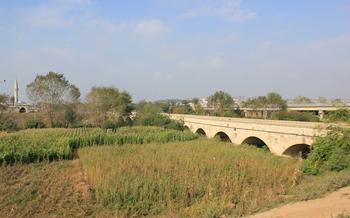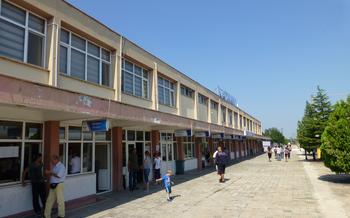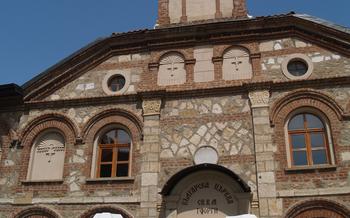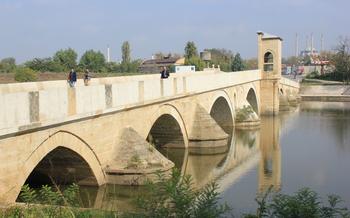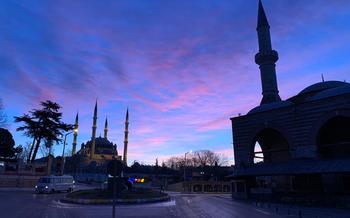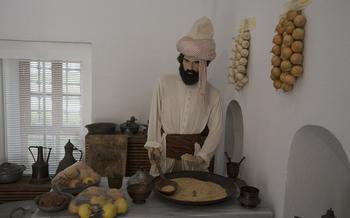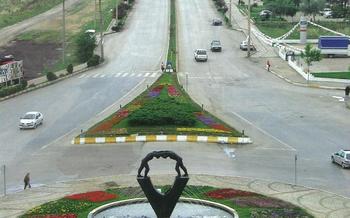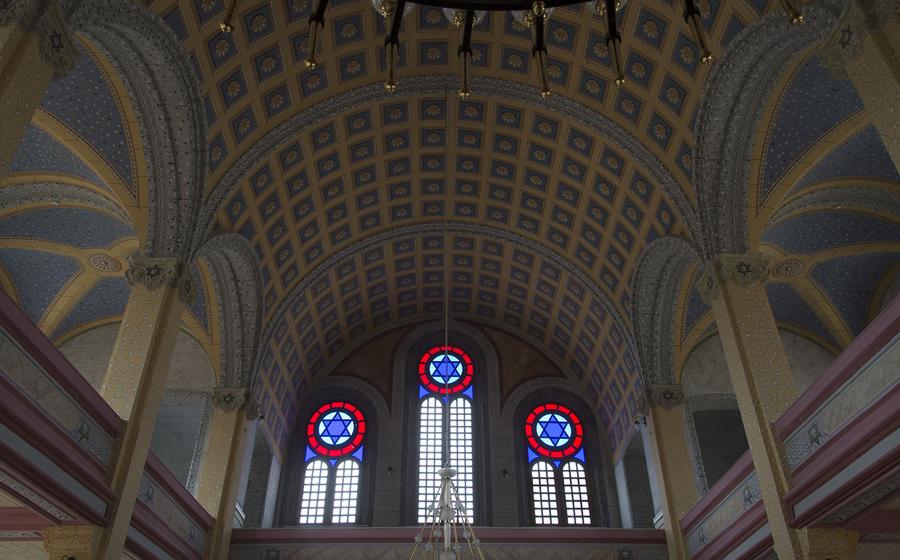
The Grand Synagogue of Edirne
- History of the Grand Synagogue of Edirne
- Significance of the Synagogue
- Exterior Architecture
- Interior Design
- Women's Gallery
- The Mikveh
- The Clock Tower
- Restoration and Preservation
- Visiting the Synagogue
- Guided Tours
- Local Traditions and Customs
- Nearby Attractions
- Local Cuisine
- Accommodations and Transportation
- Insider Tip: Hidden Gem
History of the Grand Synagogue of Edirne
Constructed between 1905 and 1907, the awe-inspiring Grand Synagogue of Edirne stands as a testament to the city's rich Jewish heritage. The mastermind behind its design was a renowned architect named Eliyahu Bali, who infused the building with a harmonious blend of Ottoman and European architectural styles.
During the Ottoman Empire, Edirne served as a vibrant hub for the Jewish community. The city welcomed Jewish families from across the empire, fostering an atmosphere of tolerance and coexistence. The Grand Synagogue emerged as the spiritual and cultural epicenter of this thriving community, a place where the faithful gathered to pray, celebrate, and connect with one another.
Significance of the Synagogue
The Grand Synagogue of Edirne holds immense significance as one of the most prominent synagogues in Turkey, embodying the city's rich Jewish heritage. Constructed during the Ottoman Empire, the synagogue served as a spiritual and cultural hub for the Jewish community, fostering a sense of belonging and identity. Its architectural splendor and historical value have earned it recognition as a symbol of tolerance and coexistence during the Ottoman era, showcasing the empire's commitment to religious diversity and harmony. The synagogue stands as a testament to the vibrant Jewish life that once flourished in Edirne, contributing to the city's cultural tapestry and leaving an indelible mark on its history.
Exterior Architecture
The exterior of the Grand Synagogue of Edirne showcases a blend of architectural styles, reflecting the various periods of its construction and renovation. The facade of the building is dominated by two large arched entrances, each topped with a triangular pediment. The pediments feature intricate carvings and inscriptions in both Hebrew and Turkish, adding to the synagogue's unique aesthetic.
One of the most striking features of the exterior is the row of arched windows that line the upper level of the building. These windows are decorated with colorful stained glass panels, depicting scenes from the Hebrew Bible and Jewish history. The stained glass windows not only provide natural light to the interior but also contribute to the synagogue's overall grandeur.
The synagogue's exterior is further embellished with decorative elements such as stone carvings, moldings, and cornices. The overall effect is one of architectural harmony and elegance, making the Grand Synagogue of Edirne a true masterpiece of its time.
In comparison to other synagogues in the region, the Grand Synagogue of Edirne stands out for its sheer size and grandeur. It is one of the largest synagogues in Turkey and is considered a prime example of Ottoman-era synagogue architecture. Its unique blend of Islamic and Jewish motifs reflects the cultural diversity and tolerance that characterized the Ottoman Empire.
Interior Design
The interior of the Grand Synagogue of Edirne is equally captivating, showcasing a blend of traditional Jewish symbolism and exquisite craftsmanship. The main prayer hall, known as the sanctuary, is a spacious and awe-inspiring chamber. Its high ceiling is adorned with intricate paintings, creating a sense of grandeur and reverence. The walls are lined with rows of wooden benches, meticulously carved with intricate designs, providing seating for the congregation during religious services.
At the eastern end of the sanctuary, the focal point of the synagogue is the Aron Kodesh (Holy Ark). This ornate cabinet houses the Torah scrolls, the sacred texts of Judaism. The Aron Kodesh is adorned with elaborate carvings, gilding, and intricate metalwork, reflecting the importance and reverence accorded to the Torah. Its doors are beautifully decorated with scenes from the Bible, adding to the overall splendor of the synagogue's interior.
In addition to the main prayer hall, the synagogue boasts several other spaces that serve various functions. These include the women's gallery, located on the upper level, offering a separate space for female congregants to participate in religious services. The synagogue also features a mikveh, a ritual bath used for purification purposes, and a clock tower, which served as a timekeeping device for the community.
Women's Gallery
In the Grand Synagogue of Edirne, the women's gallery holds a significant place, reflecting the role of women in the Jewish community. Located on the upper level of the main prayer hall, this gallery was designed to provide women with a dedicated space to participate in religious services.
The gallery's design features intricate latticework screens that separate it from the main hall, allowing women to observe the proceedings below while maintaining their privacy. This arrangement is a testament to the synagogue's commitment to inclusivity and the recognition of women's contributions to the community.
From their vantage point, women could follow the prayers, listen to the sermons, and engage in the spiritual atmosphere of the synagogue. The gallery also served as a social space, where women could gather, converse, and strengthen their bonds within the community.
The women's gallery in the Grand Synagogue of Edirne stands as a symbol of respect, equality, and the integration of women into the religious and cultural life of the Jewish community. It offers a unique perspective on the synagogue's history and the dynamic role of women within it.
The Mikveh
A mikveh is a ritual bath that holds deep significance in Judaism. It serves as a symbol of purity and spiritual renewal. The mikveh at the Grand Synagogue of Edirne is a crucial part of the synagogue complex, providing a sacred space for purification rituals.
Located within the synagogue compound, the mikveh is a subterranean chamber that features a pool of water. This pool is filled with fresh, natural water that has not been treated with chemicals or other substances. The water is continuously refreshed to ensure its purity.
Before entering the mikveh, individuals must undergo a thorough cleansing process, which includes washing their hands, feet, and body. Once cleansed, they immerse themselves in the mikveh's waters. This immersion symbolizes a spiritual rebirth, as the individual emerges from the mikveh purified and renewed.
The mikveh at the Grand Synagogue of Edirne served the Jewish community for centuries, playing a vital role in religious and cultural life. It represents the community's commitment to maintaining purity and observing Jewish traditions.
The Clock Tower
A striking feature of the synagogue complex is its clock tower, an architectural marvel that stands tall and proud, complementing the grandeur of the synagogue. The tower, a symbol of precision and timekeeping, serves as a beacon of guidance for the Jewish community. Its intricate design and craftsmanship reflect the skill and artistry of the builders, who meticulously adorned it with decorative motifs and intricate carvings.
The clock tower's strategic placement within the synagogue complex ensures that its chimes can be heard throughout the neighborhood, reminding the faithful of the passage of time and the importance of punctuality. The clock's rhythmic ticking echoes through the serene atmosphere of the synagogue, creating a sense of tranquility and order.
In addition to its practical function, the clock tower holds symbolic significance for the Jewish community. Its presence represents the community's deep-rooted connection to their faith and traditions, which have been passed down from generation to generation. The tower stands as a testament to the resilience and continuity of the Jewish people, who have faced challenges and adversity throughout history but have emerged stronger and more united.
Restoration and Preservation
Throughout history, the Grand Synagogue of Edirne has faced various challenges and undergone several restoration efforts. In the 19th century, the synagogue underwent its first major renovation, which involved repairing its roof and updating its interior decor. However, the most comprehensive restoration project took place in the early 21st century, when the synagogue received significant funding from the Turkish government and international organizations. This extensive restoration involved meticulous repairs to the building's exterior and interior, including the restoration of intricate decorative elements, the repair of structural damage, and the modernization of the synagogue's facilities to ensure its long-term preservation. The restoration process was carried out with great care and attention to detail, ensuring that the historical integrity of the synagogue was maintained while adapting it to modern needs. The successful restoration of the Grand Synagogue of Edirne stands as a testament to the importance of preserving historical landmarks and ensuring their accessibility to future generations.
Visiting the Synagogue
When visiting the Grand Synagogue of Edirne, it is crucial to be respectful of the religious and cultural significance it holds for the Jewish community. Appropriate attire, such as covering one's head for men and modest clothing for women, is expected. While photography is permitted, it is essential to be mindful of the privacy of other visitors and avoid using flash or capturing individuals without their consent.
To fully appreciate the synagogue's history and architecture, consider joining a guided tour. Local guides can provide insights into the building's unique features, its role in the community, and the stories of the Jewish people who have worshipped there. These tours typically offer an immersive experience, shedding light on the enduring heritage of the Grand Synagogue.
Guided Tours
Enhance your visit to the The Grand Synagogue of Edirne by taking advantage of the guided tours offered by local experts. These knowledgeable guides will lead you through the synagogue's history, architecture, and significance, providing insights and stories that bring the building to life.
With a guided tour, you'll gain a deeper understanding of the Jewish community's role in Edirne and the Ottoman Empire, as well as the challenges they faced and the contributions they made. Your guide will point out hidden details and explain the symbolism behind the synagogue's design, helping you appreciate its beauty and significance.
Guided tours are available in various languages and can be tailored to your specific interests, whether you're a history buff, an architecture enthusiast, or simply curious about Jewish culture. Whether you're traveling solo, with friends, or as part of a group, a guided tour is an excellent way to make the most of your visit to this remarkable synagogue.
Insider Tip: To ensure a personalized experience, consider booking a private guided tour. This way, you can have the guide's undivided attention and ask as many questions as you like.
Local Traditions and Customs
The Jewish community in Edirne has preserved many of its traditions and customs throughout the centuries, despite the challenges they have faced. One of the most significant traditions is the observance of Shabbat, the Jewish day of rest. On Shabbat, the community gathers at the synagogue for prayers and a festive meal. Another important tradition is the celebration of Jewish holidays, such as Rosh Hashanah, Yom Kippur, and Passover. During these holidays, the synagogue is decorated, and special prayers and services are held.
Visitors to Edirne have the opportunity to interact with members of the Jewish community and learn about their traditions and customs. There are several ways to do this. One option is to attend a Shabbat dinner or holiday celebration at the synagogue. Another option is to visit the local Jewish museum. The museum houses a collection of artifacts and documents that tell the story of the Jewish community in Edirne.
It is important to be respectful of local sensitivities and customs when visiting the synagogue or interacting with members of the Jewish community. For example, it is considered polite to dress modestly and to avoid wearing shorts or tank tops. It is also important to be respectful of the synagogue's religious services and to avoid talking or making noise during prayers.
Nearby Attractions
While in Edirne, take the opportunity to explore other historical sites and landmarks that showcase the city's rich cultural heritage. A visit to the Selimiye Mosque, a stunning architectural masterpiece of the Ottoman Empire, is a must. Admire its impressive dome, intricate tilework, and serene courtyard.
Don't miss the Edirne Palace, once the residence of Ottoman sultans, which now houses a museum showcasing artifacts and relics from the empire's glorious past. Immerse yourself in the city's vibrant past at the Edirne Museum, which offers a glimpse into the region's history, culture, and traditions.
For a unique experience, head to the Kırkpınar Oil Wrestling Festival, held annually in June. Witness the strength and agility of wrestlers as they compete in this traditional Turkish sport, a spectacle that draws participants and spectators from around the world.
To delve deeper into the region's history, consider visiting the Meriç River, which forms the natural border between Turkey and Bulgaria. Take a leisurely walk along its banks, enjoying the scenic vistas and the tranquil atmosphere.
Plan a comprehensive itinerary that allows you to experience the diverse offerings of Edirne. Allocate ample time to explore the city's historical landmarks, savor its culinary delights, and engage with the friendly locals. Whether you're a history buff, a nature enthusiast, or a food lover, Edirne has something to offer every traveler.
Local Cuisine
Edirne's cuisine is a delightful blend of Turkish and Balkan flavors, with unique dishes influenced by the city's rich history and diverse population. One must-try delicacy is "Kavala kurabiyesi", a traditional sweet pastry filled with walnuts and honey, named after the neighboring Greek city of Kavala. "Ciğer tava", a dish of pan-fried liver, is another local favorite, often served with fresh onions and tomatoes. For a taste of Edirne's Ottoman heritage, try the "Edirne tava", a succulent stew made with lamb, eggplant, and tomatoes. When it comes to desserts, the city is known for its "Kadayıf", a shredded filo dough pastry filled with chopped walnuts and soaked in sweet syrup. To savor the flavors of Edirne like a local, head to one of the traditional restaurants or eateries in the city center, where you can indulge in a feast of culinary delights.
Accommodations and Transportation
When planning your visit to the Grand Synagogue of Edirne, finding suitable accommodations and transportation is essential. Accommodation options near the synagogue are varied, ranging from budget-friendly guesthouses to comfortable hotels. To immerse yourself in the local atmosphere, consider staying in the charming historical district, where you can easily explore the city's landmarks on foot.
Transportation to Edirne is convenient, with regular bus and train services connecting the city to major destinations in Turkey. For a more flexible and personalized experience, renting a car is a great option, allowing you to explore the region at your own pace. To find the best deals and discounts, book your accommodations and transportation in advance, especially during peak tourist season.
Insider Tip: Hidden Gem
Beyond the main prayer hall and the women's gallery, there lies a hidden gem within the Grand Synagogue of Edirne that often goes unnoticed by visitors. Tucked away in a secluded corner of the synagogue complex is a small, unassuming room known as the "secret chamber." This hidden chamber holds a remarkable collection of ancient Jewish manuscripts, religious artifacts, and historical documents that provide a glimpse into the rich cultural heritage of the Jewish community in Edirne.
The secret chamber was once used as a meeting place for the synagogue's elders and served as a repository for important communal records. Over the centuries, it became a repository of priceless artifacts, including handwritten Torah scrolls, illuminated manuscripts, and rare books. The collection in the secret chamber offers a fascinating glimpse into the religious, cultural, and intellectual life of the Jewish community in Edirne throughout the ages.
While the secret chamber is not always open to the public, visitors who are fortunate enough to gain access will be rewarded with a truly unique and enriching experience. It is a place where history comes alive and visitors can feel a tangible connection to the past. Whether you are a history buff, a religious scholar, or simply someone with an appreciation for hidden treasures, the secret chamber of the Grand Synagogue of Edirne is a must-see for anyone visiting this remarkable city.

